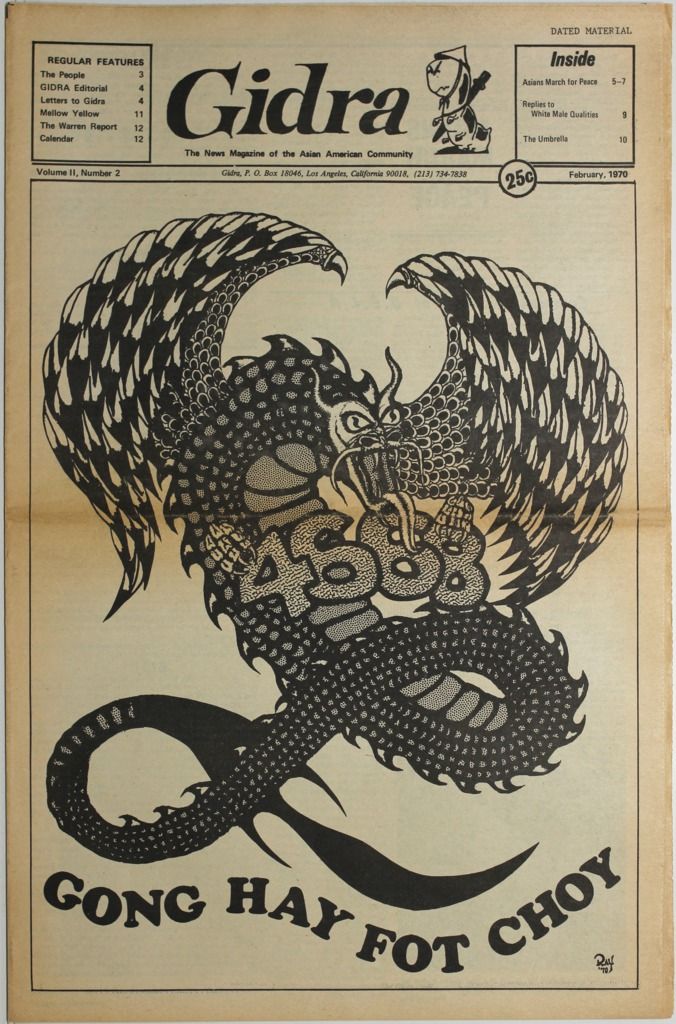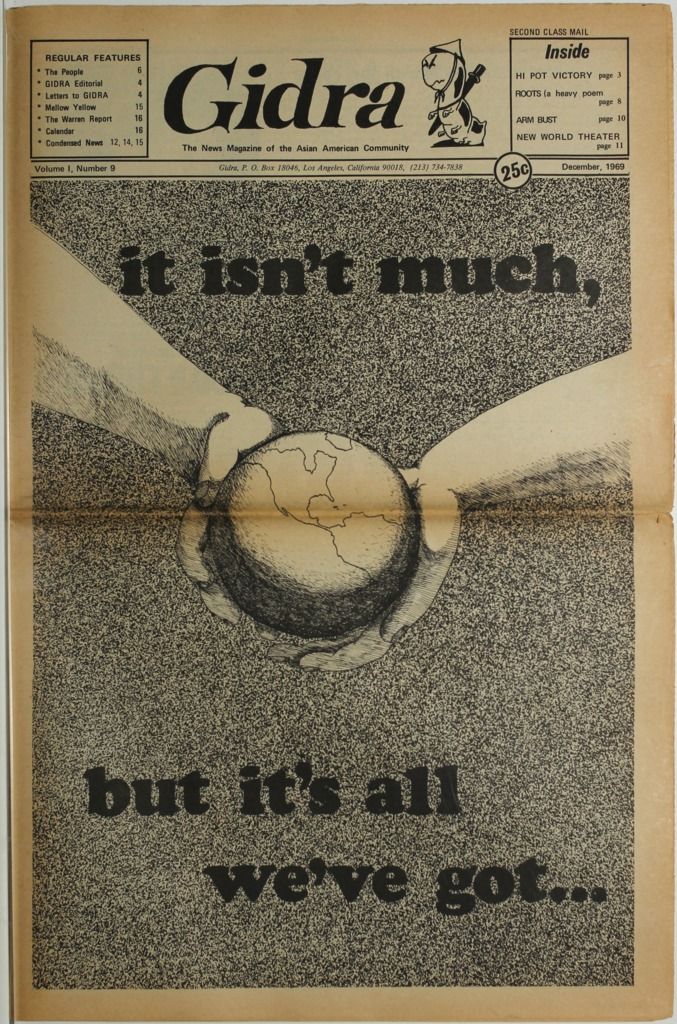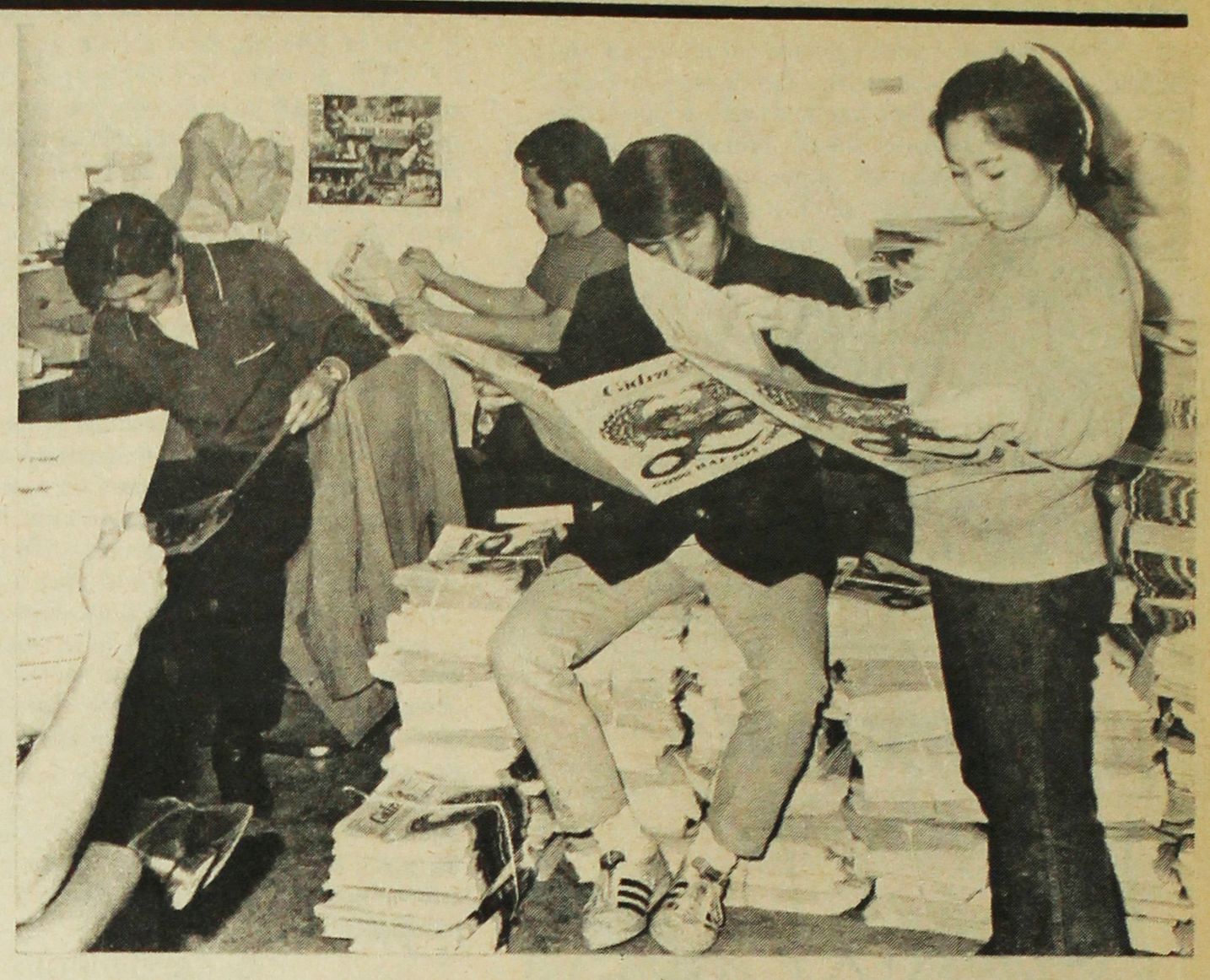
In February 1969, from the enthusiasm of five students, with $100 from each of their pockets, at the University of California in Los Angeles, the journal Gidra was born. As the first widely circulated periodical representing Asian Americans’ voices during the movement dedicated specifically to their rights, Gidra debuted with an article specifically exploring the feminist voice of Asian American women. Over its next five years of publishing, the scope of the magazine shifted away from the University’s curriculum and regional events, to national and international communities. It developed an Asian American identity advocating for Asian unity, especially after the team had moved its offices from UCLA’s campus to LA’s Crenshaw neighborhood in 1970.
From then onwards, Gidra explored Asian American history in tandem with Asia-Pacific histories, and social institutions of oppression, thereby taking a stand against various forms of discrimination and inequality in the United States and beyond.

Almost fifty years later, in 2018, a 17-minute drive north from Crenshaw Blvd in Hollywood, Crazy Rich Asians became the first movie to feature an all-Asian cast alongside a “feminist” lead in 25 years of US mainstream film making. It was met with extensive praise and acclaim, celebrated as the latest evidence of diverse representation, lauded a triumph for Asian Americans, and solidified as a beacon of social progress. Yet in 2019, a new group of Asian Americans announced the return of Gidra down the street from the film’s studio lot, thereby challenging what Crazy Rich Asian had come to represent.
When Gidra first emerged in the late 60s, it was a reaction to the long-standing oppression Asian Americans had suffered. Now, the re-emergence of Gidra in the twenty-first century represents an urgent need to form a new community against the oppression Asian people still face in the United States and beyond. With these two contradictory understandings of society’s perspectives on the empowerment of Asian Americans in mind, comparing the female voices in Gidra and Crazy Rich Asians is a starting point to better identify the real challenges Asian women face today. Social progress is more complex than simply making it onto the silver screen.
“Social progress is more complex than simply making it onto the silver screen.”
“It is not enough that we must ‘kow tow’ to the Yellow male ego, but we must do this by aping the Madison Avenue and Hollywood version of White femininity. All the peroxide, foam rubber, and scotch tape will not transform you into what you are not,” the writer Dinora Gil wrote in Gidra’s first issue, in 1969. Her essay ‘Yellow Prostitution’ asked readers to carefully consider the importance of Asian American women’s oppression, proposing to abandon the mainstream beauty standards, arguing that it led not to liberation, but self-degradation. Or, as Gil put it, “You will always be inferior if you strive to become that which you can never be.”






Different covers of Gidra (Images: Courtesy of Gidra, Densho)
In Crazy Rich Asians, the need of the lead, Rachel, to attain approval from her boyfriend’s family is what drives the plot. As she prepares with her friends for a big wedding, where she’ll demand respect from her partner’s family, one friend remarks, “I’m thinkin’ eyebrow triage, root crimps, maybe some eyelid tape. What do you think?” To which another friend replies, “Ugh, all of it.”
Anti-capitalist Gidra also critiqued the endless consumption that mainstream beauty standards bring along with them, thereby feeding back capital to the companies that had caused them in the first place. Some issues of Gidra included instructions on how to make one’s own clothes, thereby urging its readers to resist the temptation to be consumers of the clothing industry, which is still highly profitable at the expense of thousands of hugely exploited female workers.
“Anti-capitalist Gidra critiqued the endless consumption that mainstream beauty standards bring along with them.”
In Crazy Rich Asians, this interconnected understanding of exploitation is lacking. In the same scene of getting dressed before a big wedding, one friend commands Rachel, the lead to, “Pull the plum Balenciaga, the peach Chloe, the Giambattista, all the Bottegas.” It is only once these items were pulled, that Rachel feels empowered enough to face the people who belittle her. In another scene, often viewed as symbolic of women’s liberation, a different character, Astrid, leaves her cheating husband, who always felt threatened by her wealth. At the end of the movie, Astrid looks at herself in the mirror with confidence and proudly puts in her $1.2 million earrings, which were paid for by her inheritance accumulated from her father’s family business.

After the relocation in 1970, Gidra extended its scope to international communities and published articles on places such as Okinawa, Lao, and Vietnam, where people suffered from imperialist wars and capitalist exploitation. One article was based on a meeting with the Vietnamese Women’s Union. In the piece, we can recognize the attempt of Gidra’s female members to imagine what an Asian women’s movement could look like by learning from while also supporting others.
In Crazy Rich Asians, on the other hand, Rachel chooses to be on the side of the oppressor, by endorsing a new form of capitalist strategy that reinforces the status quo. In one scene when Rachel praises the Malay Princess, Intan, a character at the top of a social hierarchy, claiming that the Princess’ micro-loans had helped women and that it was women who lifted up economies. The two bond over this seemingly humanitarian comment, which also impresses the rest of the wedding group.
“Crazy Rich Asians represents the successful incorporation of Asian American feminism as a marketing strategy.”
Micro-credit as a debt-based financing service that targets poor rural women in the Global South has, however, been critiqued by many scholars from the late 90s onwards, for its role in reinforcing the patriarchal norms of women’s subordination. One research conducted in Bangladesh by Anne Marie Goetz and Rina Sen Gupta in 1996, for instance, explores the varying degrees to which female borrowers control their loans directly. It found that a significant proportion of women's loans are controlled by male relatives. Another research in 1999 by scholar Mark Schreiner also shows that this service has actually been moving loan recipients out of state-funded welfare programs instead of moving them out of poverty.
Crazy Rich Asians is not a beacon of social progress. Rather, it represents the successful incorporation of Asian American feminism as a marketing strategy. The Hollywood movie exemplifies the increasing linking of economic development with racial and gender progress. The popularity of it shows how forms of capitalist exploitation, when entwined with the rhetoric of racial and gender equality, can easily slip past public criticism. Within this context, the original Gidra reminds us to carefully examine the things around us and to think beyond an individual’s gender and skin color. Just as the inspiration behind the newspaper’s name, King Ghidorah, is a three-headed dragon, our world is more multifaceted than it sometimes appears to be.
Yanchi Huang (she/her) is a graphic designer from Taiwan, based in Los Angeles. Her practice, situated between visual and critical design, concerns the sociopolitical aspects of material and visual culture.
This text was produced as part of the L.i.P. workshop, and has previously been published in the Feminist Findings zine.













